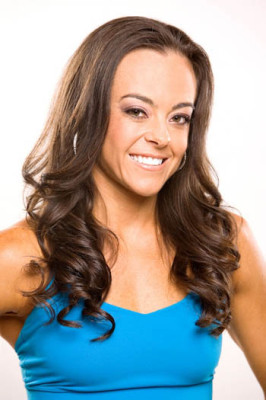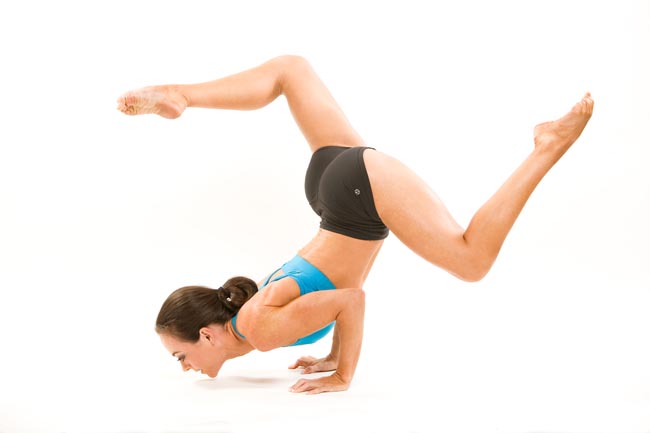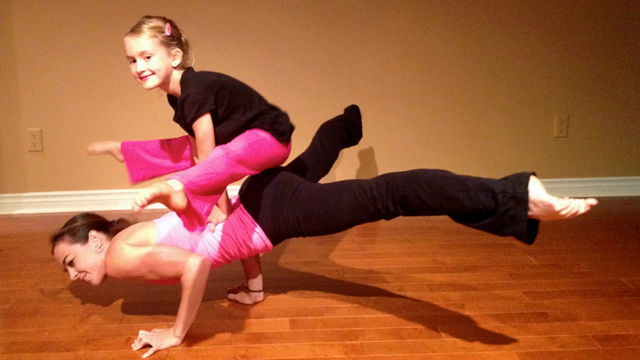7 Ways to Promote Kids’ Healthy Body Image & Active Lifestyle
The following is a guest post written by Kristy Lee Wilson, fitness champion, successful entrepreneur, certified personal trainer, and former Cirque du Soleil star.
Kristy recently contributed to the best-selling The Definitive Guide to Youth Athletic Strength, Conditioning and Performance and is also a fitness expert for Dr. Mehmet Oz’s ShareCare site. She is a USANA Associate and wrote the following in support of USANA’s United for Youth campaign.

Kristy Lee Wilson offers 7 tips for raising children with a healthy body image and a love for being active.
In today’s society, presenting a balanced picture of health and nutrition is not an easy task. The latest nutrition reports are often reported as fact, and that can leave us wondering which foods are really good for us.
In addition, children are sent all kinds of mixed messages from television, the Internet and magazines. The images they see are of profoundly “beautiful” people — thin, rich, and happy. These same “beautiful” people are frequently seen advertising candy, soft drinks, and fast food, which have little nutritional value.
These unhealthy foods and beverages are among the most-advertised products on children’s TV programs. Studies show a direct correlation between the number of hours spent watching television and the number of requests made from children to want the products they see advertised.
Not only are we getting fatter, but we are also getting more self-conscious about it, and this is being seen in children at a very young age. More and more girls, as young as 10 years old, are voicing dissatisfaction with their bodies and expressing a desire to be thinner. I know this to be true as this is the same age I developed my own eating disorder.
Parents have a powerful influence on their children’s self-esteem and body image. It is crucial for parents to set a good example in regards to living a healthy lifestyle. They help children build a healthy body image and prevent excessive dieting and other destructive body image behaviors. These behaviors must start early as the earlier destructive behaviors begin, the harder they are to break as adults.
Here are some ways we can help our children:
1. Watch what you say!
As a parent, how do you talk about your own body? Do you criticize it? Would you talk to your friends the same way you talk to yourself about your own body? My guess is probably not. Chances are, if you did, you may not have many friends left. What is the value in hating your body? When you talk negatively about yourself in front of your children, you are giving them a very clear message that it’s acceptable to not like yourself. Children are like sponges. They hear everything and soak it all in.
2. Educate your children about health, nutrition, and exercise.
With all the information — and misinformation — out there about nutrition and exercise, how to eat and exercise for optimal health benefits can become very confusing! Teach your children the facts about health. Explain to them that body size is NOT necessarily an indicator of health. There are skinny people with thin bodies that are not healthy, and there are some bigger people who may be considered overweight but are in fact healthy. Body size does not determine health status.
3. What’s in your house?
What message are you sending to your children by what you have in the house? Do you have diet products and magazines of the latest fashion models lying around? Or do you have health and fitness magazines? Is your kitchen full of fresh fruits, vegetables, Nutrimeals and healthy snack bars that complement your message of eating well and living a healthy lifestyle? Make sure what is in your house also communicates the message you want to send to your children.
4. Give your children a choice.
Don’t ever try to force foods and activity on your children. Children should have a choice over their eating, activity, and control over their own bodies. Provide your children with a healthful selection of foods and let them make some decisions. Children have an amazing ability to self-regulate their diet. Trust me, they will never go hungry given a choice. When you attempt to control a child’s food intake you could impair the development of their normal eating habits, causing more harm than good.
5. Help your children understand their bodies will change and grow.
There is not one ideal body type. We are all different. People come in all different colors, shapes, and sizes. If you hear your child complain about being too fat, skinny, short, or tall, emphasize that there is no “ideal” way to look and no such thing as a “perfect” body. What’s most important is practicing a healthy lifestyle that includes consuming good nutrition and being physically active each and every day.
6. Discourage your children from weighing themselves too often.
What does a number on the scale mean? This number doesn’t tell you how healthy you are. It doesn’t tell you how much fat or how much lean muscle you have. It doesn’t tell you your blood pressure or cholesterol levels. Use the scale as a guide, but never weigh yourself or your children more than once a week. Obsession with the number on a scale can become very destructive very quickly. Focus on health — eating a well-balanced diet and getting plenty of physical activity on a regular basis. Forget about that digital number between your child’s feet.
7. Be a fit role model.
Monkey see, monkey do. Be a role model by promoting physical activity and exercise. If children see their parents happy, fit, enjoying life and having fun, they will want to be that way, too. Children, especially girls, who play sports or participate in regular physical activity tend to have higher levels of self-esteem, as well as healthier body images. Strong is now the new skinny. Show your children that fitness is fun. Be active together as a family. Have a family fun day, or take daily walks or bike rides together. This can also be a great time for some family bonding.
 The absolute best thing you can do to help your children develop healthy habits and a healthy body image is to be happy with who you are. Accept yourself—no one is perfect. Promote a healthy lifestyle by engaging in regular physical activity and choosing nutritious food choices. Your family will follow your lead, and your children are much more likely to grow up happy and healthy.
The absolute best thing you can do to help your children develop healthy habits and a healthy body image is to be happy with who you are. Accept yourself—no one is perfect. Promote a healthy lifestyle by engaging in regular physical activity and choosing nutritious food choices. Your family will follow your lead, and your children are much more likely to grow up happy and healthy.
How about you?
What do you to to help raise children with a healthy body image and a love for being active? Let us know in the comments!
If you’re not doing so already, be sure to follow Kristy on Twitter (@KristyLeeWilson) and like her on Facebook. To pick up a copy of The Definitive Guide to Youth Athletic Strength, Conditioning and Performance, visit www.kristywilson.com.
We’re proud to bring you the freshest content on the web! Follow USANA on Twitter, like our USANA Facebook page and enjoy the latest videos on the official USANA YouTube channel.
Learn what USANA is doing to make the world a better place.
Discover what USANA products can do to boost your health by taking this brief online Health Assessment.








This is a great article. Thank You.
Being a personal trainier I get the oportunity to help youth all the time. The first thing I do is sit down and discuss health and wellness with the youth. Diet, Exercise, Sleep, Stress and Nutritional Supplements. I get a good idea on what is in the house and what is going to school with them (lunch or lunch money). I then meet with the parents and the youth and we work out how to move to a healthier aproach to life and we all make a deal to help make small changes everyday to move them towards their health goals. I definitely focus on health first and what that may look like for them.
Thanks again for a great post.